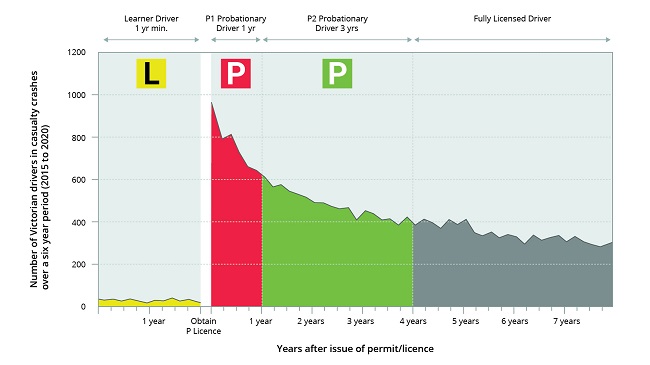Reducing P driver crash risk
P drivers have more crashes than any other road users. Learn about the risks of crashing and how young people can avoid high risk situations.
P drivers have more crashes than any other road users, and road crashes account for 1 in 5 deaths for people aged 15-24. This graph shows that a P driver’s first year of driving is the most dangerous.

Click to enlarge
Victoria’s Graduated Licensing System (GLS) helps young drivers stay safe by introducing them to driving in stages. The special rules that apply to P1 and P2 drivers are designed to reduce their risk in the first years of driving – the years that that we know are the most dangerous.
High risk situations
Many situations are known to result in a higher crash risk for new drivers. Special rules that apply to P1 and P2 drivers address many of these risks, and careful decision-making before and during driving in the first year as a P driver can help to avoid other known risks for new drivers.
Driving at night
This graph shows that P drivers are much more likely to be involved in a crash late at night (10pm-6am). Night driving is riskier than driving during the day because of the effect of tiredness and because it’s harder to see and judge things.

What P drivers can do?
- Share a taxi with friends.
- Drive (reasonably early) with no more than one friend.
- Stay the night if safe and drive home in the morning.
- Use public transport with friends, including night rider buses, where available.
- Get a lift with a more experienced driver, such as a fully licensed driver or someone who has been driving on Ps for at least a year.
- Ask parents for supervision when driving at night. (Driving supervision can still be helpful to develop skills for P-drivers!)
What parents can do?
- Agree that for the first three to six months of the probationary period there will be no late night driving (after 10pm) without a parent supervising. This will have implications for both P driver and parent, but will mean that they will be safer and can eventually drive more safely at night on their own.
Driving with multiple passengers
P drivers are much more likely to be involved in a fatality crash if they carry more than one passenger. Many first year P drivers involved in fatal crashes are carrying two or more passengers. This graph shows that P drivers with passengers have four times the risk of crashing.

Peer passengers affected by alcohol can pose a dangerous distraction for an inexperienced driver. A group of peer passengers can also directly and indirectly encourage risk taking behaviour.
Rule: P1 drivers cannot carry more than one passenger aged 16 to under 22 years of age at any time, day or night.
Other high risk situations
Other high crash risk situations to be avoided include driving:
- When tired.
- In poor weather conditions.
- While impaired by alcohol or drugs.
- Using mobile phones and other portable devices.
- On unfamiliar roads or in unfamiliar driving conditions.
- At dusk or dawn when there are sun glare problems.
- When distracted.
Refer to the Rules for P Drivers handbook for more information about rules and solutions to address risks for P1 and P2 drivers.
New distracted driver road rules
From 31 March 2023 changes to road rules apply regarding the use of portable, wearable, inbuilt, and mounted devices while driving a vehicle or riding a motorbike. Penalties apply for the use of these devices and for seatbelt related offences that are now detectable by cameras. You can download a summary of changes here Distracted Driver Road Rules 2023 [PDF 409 Kb] or learn more using the link below.